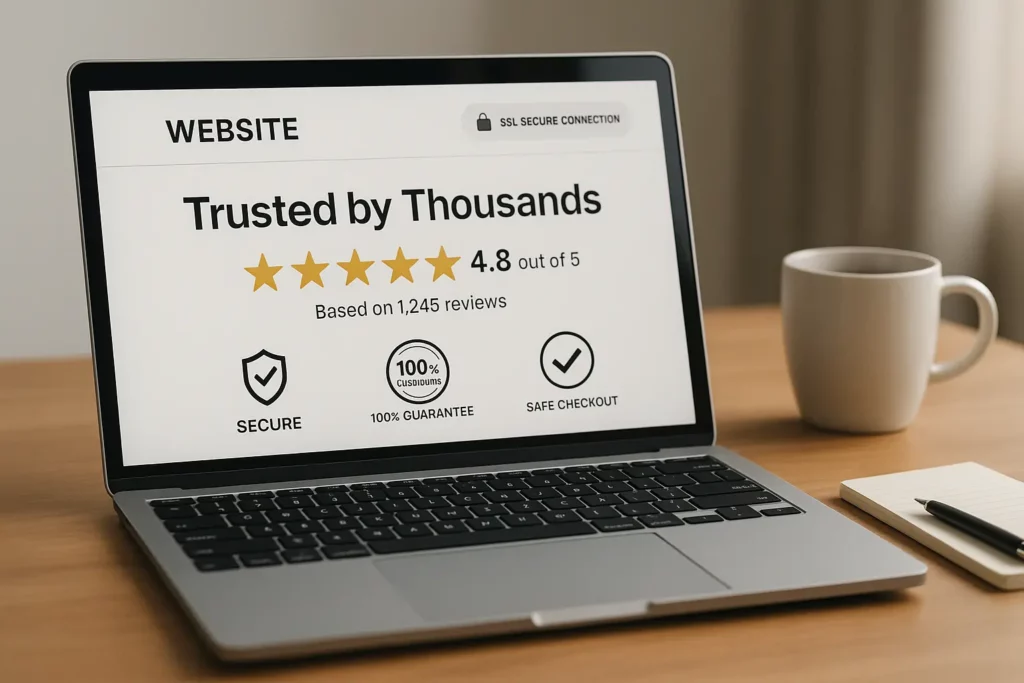Introduction: The $50 Billion Trust Problem (And How to Solve It)
Picture this: A potential customer lands on your website, credit card in hand, ready to buy. But something feels… off. Maybe it’s the generic stock photo of a handshake, or the fact that your “contact us” page is mysteriously vague. Within 0.05 seconds—literally faster than a blink—they’ve made their decision.
Click. Gone.
You just lost a sale to something most business owners never think about: trust signals.
Here’s the kicker: According to the Baymard Institute’s latest research, trust-related concerns cause over $50 billion in abandoned online purchases annually, with 18% of users abandoning carts due to security concerns alone. That’s not a typo—billion with a ‘B’. And the tragic part? Most of these losses are completely preventable.
Think of your website like a first date. You wouldn’t show up wearing a mysterious mask and refuse to tell them your last name, right? Yet that’s essentially what many websites do—they ask for money, personal information, and loyalty while giving visitors zero reason to trust them.
The good news? Building trust online isn’t rocket science. It’s psychology, and once you understand what makes visitors feel safe, you can transform those nervous browsers into confident buyers.
What Are Website Trust Signals? (The Psychology Behind the Click)
Let’s start with a simple truth: your brain is wired for survival, not shopping. When our ancestors encountered something new, they had milliseconds to decide: friend or foe? Safe or dangerous?
Your website visitors’ brains are running this exact same program, just updated for the digital age. Instead of “Will this saber-tooth tiger eat me?” it’s “Will this website steal my credit card number?”
The Psychology of Online Trust
Trust isn’t built on logic—it’s built on feeling. When someone visits your site, their subconscious is frantically scanning for answers to three critical questions:
- Is this legitimate? (Will they actually deliver what they promise?)
- Is this safe? (Will they protect my data and money?)
- Are they competent? (Do they know what they’re doing?)
Trust signals are your website’s way of saying “yes, yes, and absolutely yes” to all three questions.
Trust Signals vs. Trust Badges: What’s the Difference?
Here’s where people get confused. Trust badges are the specific little icons—those “Verified by Visa” or “BBB Accredited” logos. Trust signals are everything that communicates trustworthiness, including:
- That professional headshot of your CEO (not a stock photo)
- Your detailed “About Us” story
- Those glowing customer reviews
- The way your site loads lightning-fast
- Even your choice of fonts (seriously—Comic Sans kills credibility)
Think of trust badges as your website’s credentials, while trust signals are its entire personality.
Types of Website Trust Signals (Your Trust-Building Toolkit)
1. Security Trust Signals: The Digital Bodyguards
SSL Certificates & HTTPS If your URL doesn’t start with “https://” in 2025, you might as well put up a neon sign that says “Hack Me.” SSL certificates are like the bouncer at an exclusive club—they keep the bad guys out and let your visitors know they’re in a protected space.
Pro tip: That little padlock icon in the browser bar? It’s worth its weight in gold. Studies by Google show that 84% of users will abandon a purchase if they notice the connection isn’t secure.
Privacy Policy & Terms of Service I get it—nobody actually reads these. But their presence tells visitors you’re a legitimate business that takes data protection seriously. It’s like wearing a seatbelt—you hope you’ll never need it, but you’re sure glad it’s there.
Make it human: Instead of legal jargon, write your privacy policy in plain English. “We’ll never sell your email to spammers” hits different than “We do not engage in third-party data monetization.”
Visible Security Badges Norton Secured, McAfee, SSL certificates—these badges are like digital trust trophies. But here’s the catch: only use legitimate ones. Fake security badges are like fake Rolex watches—they fool some people, but when the truth comes out, your reputation is toast.
2. Social Proof Signals: Let Your Customers Do the Talking
Customer Reviews and Ratings Reviews are social proof on steroids. When someone sees that 2,847 other people loved your product, their brain thinks: “Well, if it’s good enough for them…”
But here’s what most businesses get wrong: they only show 5-star reviews. Big mistake. A mix of reviews (mostly positive with some 4-stars) actually looks more authentic. Perfect scores scream “fake” to modern consumers.
Video Testimonials: The Trust Signal Superpower Anyone can write a fake review. It’s much harder to fake a video testimonial. When potential customers see real people sharing genuine experiences, it’s like having a trusted friend make a recommendation.
Case Studies That Prove Results Don’t just tell visitors you’re great—prove it. A detailed case study showing how you helped Customer X achieve Result Y is worth more than a thousand generic testimonials.
Example: Instead of “Great service! – John D.” try “How we helped John’s local bakery increase online orders by 340% in 90 days” with specific details, challenges, and solutions.
3. Visual Trust Signals: First Impressions Matter
Clean, Professional Design Your website design is like your business’s storefront. A cluttered, outdated design is like having a store with broken windows and peeling paint—it doesn’t matter how good your products are.
Consistent Branding and Typography Consistency breeds familiarity, and familiarity breeds trust. If your logo changes colors between pages or your fonts look like they were chosen by throwing darts at a typography chart, visitors will notice (even if they can’t explain why something feels “off”).
High-Quality Images (Not Stock Photos) We need to talk about stock photos. You know the ones—perfectly diverse groups of people in business casual pointing at laptops and laughing at salads. They scream “generic” louder than a megaphone.
Instead, invest in authentic photos of your actual team, products, and workspace. Even smartphone photos of your real office beat stock photos of fake offices.
4. Authority Signals: Show Off Your Credentials
Certifications and Credentials Industry certifications are like diplomas for your business. ISO certifications, PCI-DSS compliance, industry-specific accreditations—these tell visitors you’ve been vetted by third parties.
Awards and Industry Recognition “Winner of the 2024 Best Customer Service Award” carries weight because it’s not something you gave yourself (unlike “World’s Best Website”—sorry, but your mom’s opinion doesn’t count here).
Media Mentions and Press Coverage “As featured in TechCrunch” or “Mentioned in Forbes” work because they leverage borrowed authority. If these trusted publications wrote about you, you must be worth paying attention to.
5. Transparency Signals: Let People Behind the Curtain
A Real About Us Page Your About Us page might be the most important page on your site. It’s where visitors decide if you’re real people with a real business or some mysterious entity operating from a basement somewhere.
Include real photos, real names, and your actual story. Why did you start this business? What’s your mission? Who’s on your team? Make it personal, make it human.
Easy-to-Find Contact Information If visitors have to play detective to find your phone number, they’ll assume you’re hiding something. Display your contact info prominently—address, phone, email, and ideally live chat.
Bonus points: Include a Google Maps embed of your actual location. It shows you’re not afraid to be found.
Transparent Pricing “Contact us for pricing” is often code for “We’ll charge whatever we think you can afford.” Be upfront about costs. If your pricing is complex, explain why.
6. E-Commerce Trust Signals: Making Online Shopping Feel Safe
Secure Payment Gateways PayPal, Stripe, Apple Pay—these aren’t just payment processors, they’re trust builders. When customers see these familiar logos, they know their payment information is handled by companies that spend millions on security.
Clear Return and Refund Policies A generous return policy is actually a sales tool in disguise. It removes the risk from the customer’s decision. According to research by UPS, 68% of customers check return policies before making a purchase, and clear return policies can increase conversion rates by up to 357%.
Delivery Guarantees and Shipping Information Nobody likes surprises when it comes to shipping costs and delivery times. Be upfront: “Free shipping on orders over $50” or “Get it tomorrow with Prime.” Transparency here prevents cart abandonment.
How Website Trust Signals Actually Improve Your Bottom Line
Lower Bounce Rates = Better SEO Rankings
When visitors trust your site, they stick around longer. They explore multiple pages, read your content, and engage with your brand. Google notices this behavior and thinks: “This site must be valuable—people love spending time here.”
Result? Better search rankings and more organic traffic.
Higher Conversion Rates = More Revenue
Trust directly impacts conversion rates. A comprehensive study by ConversionXL found that adding trust signals can increase conversions by 42%. Meanwhile, Edelman’s Trust Barometer reports that 81% of consumers say they must trust a brand before making a purchase.
Better Search Engine Rankings = More Visibility
Google’s E-E-A-T framework (Experience, Expertise, Authoritativeness, Trustworthiness) isn’t just SEO jargon—it’s a blueprint for building trust. According to Google’s Search Quality Rater Guidelines, trust is a critical ranking factor. The more trust signals you have, the more Google trusts you, and the higher you rank.
The Trust Signal Implementation Playbook
Phase 1: The Quick Wins (Do These Today)
The 30-Minute Trust Boost:
- Add SSL certificate (if you don’t have one)
- Update your About Us page with real photos and story
- Add your physical address and phone number to every page
- Check that all your trust badges are legitimate and up-to-date
- Add customer reviews to your homepage
Phase 2: The Trust Builders (This Week)
The Strategic Trust Investment:
- Create video testimonials from happy customers
- Write detailed case studies with specific results
- Get legitimate industry certifications
- Implement live chat for instant support
- Create a comprehensive FAQ section
Phase 3: The Trust Maximizers (This Month)
The Advanced Trust Strategy:
- Build relationships with industry publications for press coverage
- Create a customer success story series
- Implement schema markup for reviews and ratings
- Start a customer loyalty program
- Get listed in industry directories and review sites
Common Trust Signal Mistakes (And How to Avoid Them)
Mistake #1: Using Fake Reviews or Testimonials
The internet has made verification easy. If your “customer” testimonial comes from someone whose LinkedIn says they work at your company, people will notice. And when they do, they’ll never trust you again.
Solution: Use real reviews from real customers. If you don’t have many yet, focus on getting them rather than faking them.
Mistake #2: Trust Badge Overload
More isn’t always better. Having 47 different trust badges on your checkout page doesn’t make you look more trustworthy—it makes you look desperate.
Solution: Choose 3-5 legitimate, relevant trust badges and place them strategically near your call-to-action buttons.
Mistake #3: Ignoring Mobile Trust Signals
If your trust signals don’t work on mobile, you’re missing 60%+ of your traffic. That tiny trust badge that looks great on desktop might be unreadable on a smartphone.
Solution: Test your trust signals on multiple devices and screen sizes. Make sure they’re visible and clickable on mobile.
Mistake #4: Outdated Information
Nothing kills trust faster than expired certifications, broken links, or outdated testimonials. It’s like having a “Fresh Fish Daily” sign in front of a restaurant that’s been closed for six months.
Solution: Set calendar reminders to review and update your trust signals quarterly.
Real-Life Trust Signal Success Stories
Case Study 1: The E-Commerce Turnaround
The Problem: Sarah’s handmade jewelry store was getting traffic but no sales. Her conversion rate was a dismal 0.3%.
The Investigation: A trust audit revealed multiple issues: no customer reviews, generic stock photos, missing contact information, and an “About Us” page that could have been written by a robot.
The Solution:
- Added real photos of Sarah in her workshop
- Created video testimonials from happy customers
- Added detailed product descriptions with sizing guides
- Implemented a 30-day money-back guarantee
- Added live chat support during business hours
The Results: Conversion rate jumped to 2.8% within 60 days—a 833% increase. Monthly revenue went from $3,200 to $31,400.
Case Study 2: The B2B Trust Transformation
The Problem: A software consulting firm was losing potential clients during the sales process. Decision-makers would show initial interest but then go quiet.
The Investigation: Their website looked like every other consulting firm—generic team photos, vague service descriptions, and no concrete examples of their work.
The Solution:
- Created detailed case studies showing specific client results
- Added certifications from Microsoft, AWS, and Google Cloud
- Included client logos and testimonials with full names and companies
- Added a “Day in the Life” video showing their development process
- Created a transparent pricing guide
The Results: Lead quality improved dramatically. Sales cycle shortened from 4 months to 6 weeks. Revenue per client increased by 40%.
The Future of Trust Signals: What’s Coming Next
AI-Powered Verification
As deepfakes and AI-generated content become more sophisticated, we’ll see new types of verification systems. Companies like Truepic are already developing blockchain-based verification for authentic content, while organizations like C2PA (Coalition for Content Provenance and Authenticity) are setting standards for content authenticity.
Personalized Trust Signals
Future websites will show different trust signals based on visitor behavior and preferences. A security-conscious visitor might see more security badges, while a price-sensitive shopper might see money-back guarantees prominently featured.
Real-Time Trust Scores
Imagine trust signals that update in real-time based on current customer satisfaction scores, recent reviews, and live performance metrics. This transparency will become the new standard.
Voice and Video Verification
With the rise of voice search and video content, we’ll see more audio and video trust signals. Think voice testimonials, video reviews, and live-streamed customer service interactions.
Your Trust Signal Audit Checklist
Security & Safety (Must-Haves):
- [ ] SSL certificate installed (HTTPS everywhere)
- [ ] Privacy policy clearly linked
- [ ] Contact information easily found
- [ ] Secure payment options displayed
- [ ] Legitimate security badges only
Social Proof (Credibility Builders):
- [ ] Customer reviews visible on key pages
- [ ] Video testimonials available
- [ ] Case studies with specific results
- [ ] Client logos (with permission)
- [ ] Social media links that actually work
Visual Credibility (Professional Image):
- [ ] Consistent branding across all pages
- [ ] Professional, authentic photography
- [ ] Clean, modern design
- [ ] Fast loading times (under 3 seconds)
- [ ] Mobile-optimized experience
Authority & Expertise (Credibility Indicators):
- [ ] Team members with real names and photos
- [ ] Industry certifications displayed
- [ ] Media mentions or press coverage
- [ ] Awards and recognition
- [ ] Educational content that demonstrates expertise
Transparency (Trust Through Openness):
- [ ] Detailed About Us story
- [ ] Clear pricing information
- [ ] Return/refund policy explained
- [ ] Terms of service available
- [ ] Physical address displayed
Conclusion: Building Trust Isn’t Optional—It’s Essential
Here’s the bottom line: In an online world where anyone can create a website in minutes, trust is your competitive advantage. It’s what separates thriving businesses from forgotten URLs.
Every trust signal you add is an investment in your business’s future. It’s the difference between a visitor who bounces in 3 seconds and a customer who buys, refers friends, and comes back for more.
Start with the quick wins—add that SSL certificate, update your About Us page, display your contact information prominently. Then work on the bigger trust builders—collect reviews, create case studies, earn certifications.
Remember: trust isn’t built overnight, but it can be destroyed in an instant. Protect it, nurture it, and watch it transform browsers into buyers, skeptics into supporters, and visitors into your biggest advocates.
Your website isn’t just a digital brochure—it’s your 24/7 salesperson, brand ambassador, and trust builder all rolled into one. Make sure it’s working as hard as you are.
Want to dive deeper into trust-building strategies? Check out the Nielsen Norman Group’s research on trust in UX design for more psychological insights into online credibility. For technical implementation, Mozilla’s Web Security Guidelines provide comprehensive security best practices.
Ready to audit your website’s trust signals? Download our free Trust Signal Checklist and discover which credibility gaps might be costing you customers.


